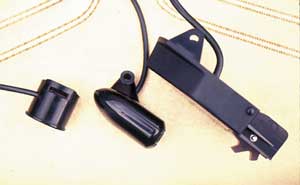
Franklinton resident Trey Riley fits into his surroundings even better than the game that frequently finds itself in his sights.
The whole idea of spring cleaning is impractical in a climate where we can boat all year so it behooves us to knock down those electrical gremlins each time they stick their heads up.
The best time to investigate that flickering running light or sounder that seems to be losing the bottom more often than it used to is as soon as you get back to the dock. The only thing better than fixing them now is to have fixed them yesterday with some standard preventative maintenance.
Sonar transducers, for instance, are the Rodney Dangerfields of marine electronics. They get no respect. We take them for granted until they stop working properly, and that’s silly because most transducer problems are preventable.
Transom-mounted transducers are the easiest to maintain on trailerable boats. Make sure the transducer’s mounting angle is correct and all its mounting hardware is tight before each launch.
If you can easily tilt a transducer by hand that uses friction to hold its front-to-rear angle or feel any sideways slack between the transducer and bracket, its hardware isn’t snug enough.
Those that use a snap-in plastic mechanism to hold their angle can’t usually be adjusted. Their angle is controlled by a wedge that was put between their mounting bracket and the transom when the transducer was installed. When these brackets get too sloppy to hold a proper angle at speed, they need to be replaced. Always proceed gently and with caution when dealing with plastic parts.
Check the bottom of your transducer for marine growth, road grime from trailering or other crud. Such gunk can partially insulate the transducer from the water and weaken sonar performance.
An easy way to clean a dirty transducer just before you launch is to dunk a dish washing sponge in the lake, squirt some environmentally friendly soap on its pot-scrubbing side, and scrub the transducer’s face until it’s clean. This goes for all exposed transducers, those on the transom, mounted through-hull or on an electric trolling motor.
Transducers mounted inside to shoot through the hull are more difficult to inspect. If you can get to them easily, it’s a good idea to check them periodically to make sure they are still glued tightly in place. If you can move them or you can see where epoxy has chipped out from under them leaving an air gap, they need to be re-installed or replaced.
Make sure your transducer cables remain properly secured. Loose cables in the cockpit area can be fatally snagged, and those in the bilge can work their way under a shifting battery box.
Inspect the other wiring associated with your electronics each time you install or remove a unit. If you leave your electronics on the boat, set aside an hour or two at least every other month to check your power cables and connectors, along with those for your antennas and transducers. Cables and wires should be safely anchored, and connections should be clean and tight.
Electrical connections are another favorite playground for gremlins. Plugs and sockets can be cleaned with a spray like RadioShack’s Precision Electronics Cleaner, and then treated with RadioShack’s Contact/Control Cleaner and Lubricant to keep them protected and working smoothly.
Hit the contacts of your fuses and their sockets with the same cleaners and lubricants. This is especially important if your boat has an open fuse block. Other protectants like CorrosionX and GT 85 will displace moisture, kill crud and help keep it from forming again.
Always confirm that a product is safe for plastics before using it near plastic plugs, receptacles and cases. Take great care to avoid getting any overspray on LCD screens. A label that reads, “Safe for Plastics,” may only mean that a product won’t dissolve plastic; it might still stain or optically distort it.
Power cable splices are best soldered and covered with heat-shrink tubing, but butt splices seem to be more the norm. Examine your splices, and give them a tug; replace any that look corroded or feel loose.
Last but certainly not least, make sure that your battery connections are clean and tight. Cruddy connections can trump all your other work and cause cruddy performance.


